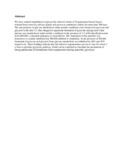| dc.contributor.author | Njogu, R M | |
| dc.contributor.author | Nyindo, M | |
| dc.date.accessioned | 2013-06-10T12:00:31Z | |
| dc.date.available | 2013-06-10T12:00:31Z | |
| dc.date.issued | 1981 | |
| dc.identifier.citation | J Parasitol. 1981 Dec;67(6):847-51 | en |
| dc.identifier.uri | http://www.ncbi.nlm.nih.gov/pubmed/7328458 | |
| dc.identifier.uri | http://erepository.uonbi.ac.ke:8080/xmlui/handle/123456789/30754 | |
| dc.description.abstract | We have studied metabolism of glucose by infective forms of Trypanosoma brucei brucei isolated from tsetse fly salivary glands and grown in continuous culture for more than 700 days. The end products of glucose metabolism under aerobic conditions were found to be pyruvate and glycerol in the ratio 3:1. this changed to equimolar formation of pyruvate and glycerol when glucose was metabolized under aerobic conditions in the presence of 1.5 mM salicylhydroxamic acid (SHAM), a situation analogous to anaerobiosis. The respiration of the parasites was insensitive to cyanide inhibition but SHAM inhibited it completely. In the presence of SHAM, formation of pyruvate and glycerol from glucose metabolism was inhibited by 60% and 45% respectively. These findings indicate that the infective trypanosomes grown in vitro for about 2 yr have a peculiar glycolytic pathway which can be exploited to elucidate the mechanism of energy production of bloodstream form trypanosomes during anaerobic glycolysis | en |
| dc.language.iso | en | en |
| dc.title | Presence of a peculiar pathway of glucose metabolism in infective forms of Trypanosoma brucei cultured from salivary glands of tsetse flies | en |
| dc.type | Article | en |
| local.publisher | Department of Biochemistry, University of Nairobi | en |

